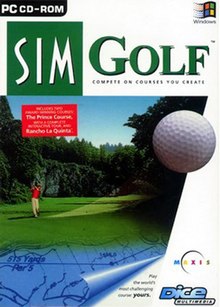| SimGolf | |
|---|---|
 | |
| Developer(s) | Tavex [1] |
| Publisher(s) | Maxis |
| Designer(s) | Vladimir Vinetsky |
| Programmer(s) | Olexander Bilyk Oleg Mouraveinick Serg Butenko Vasyl Tsvirkunov |
| Artist(s) | Sharon Barr Shannon Galvin |
| Composer(s) | Jerry Martin |
| Series | Sim |
| Platform(s) | Windows |
| Release | November 15, 1996 [2] |
| Genre(s) | Sports |
| Mode(s) | Single-player, multiplayer |
SimGolf is a sports video game created by Maxis in 1996. The game allows players to design their own golf courses and play them. [3]